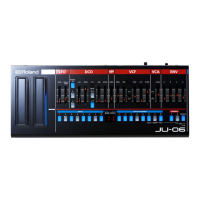II. Functions for Sound Creation
DCO
DCO is the digitally controlled oscillator that controls the pitch and creates two types of waveforms which are the
sound source of the synthesizer. Compared to VCO (Voltage Controlled Oscillator), DCO has superior stability.
The operations and functions of the DCO are virtually the same as those of the VCO.
1.
WAVEFORMS
You can select the output waveform of the DCO. Each switch can be individually turned on or off and can be
simultaneously used with another switch.
2. PWM Mode Switch
When it is set to MAN, pulse width can be set to a certain ratio. When it is set to LFO, pulse width is controlled by the
signal from the LFO.
3. PWM
When PWM Mode switch is set to MAN, this knob controls the pulse width, and controls the intensity of the
modulation when it is set to LFO
4. SUB • Sub Oscillator Level Knob
It controls the volume of the Sub Oscillator.
5 LFO • Modulation Knob
It adjusts the depth of the vibrato effect when the LFO is controlling the pitch of the DCO.
6. NOISE
It controls the volume of the NOISE.
7. Range Selector Button
This selects the pitch of the DCO. When it is set to 8', “do" (C) 3rd from the lowest falls on the Middle C of a piano
keyboard. By using 4' or 16' position, one octave is shifted up or down, changing total range of the keyboard.
When the top and bottom portions of the square wave are unequal, the result is what is called a pulse wave. The
harmonic content of the pulse wave will depend greatly on the width of the pulses, it is possible to modulate, or
change the pulse width by means of the LFO.

